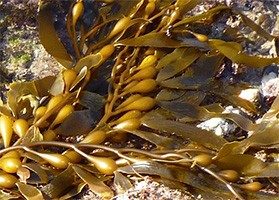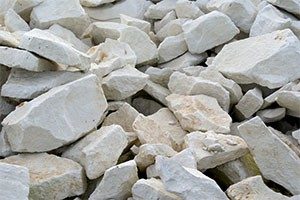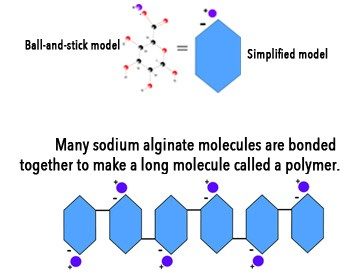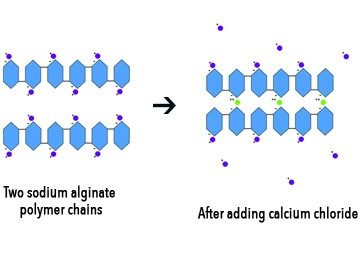Project Based Lessons - Natural Resources & Synthetic Materials
NGSS Standard: MS-PS1-3
Gather and make sense of information to describe that synthetic materials come from natural resources and impact society.
Key Concepts
- Synthetic materials are made from natural resources.
- Synthetic materials are made by chemically changing the starting substances to create a material with different characteristics.
- Some examples of synthetic materials are plastics, medicines, and new fuels.
- A synthetic substance may be chemically identical to a naturally-occurring substance or may be different.
- Making and using synthetic materials have both positive and negative impacts on society.
Summary
The teacher models and describes the kinds of information students will be looking for in their research project on a synthetic product. This is done by using an example of a synthetic product that students make in the classroom: a gel worm (not for eating.) Students make it by combining a sodium alginate solution with a calcium chloride solution. The teacher uses this product to model answers to the three questions students need to answer in their research:
- What natural resources are used to make the synthetic product?
- What chemical processes are used to make the synthetic product?
- What are the negative and positive impacts to society of making and using the synthetic product, compared to making and using a more natural product with a similar function?
Students choose or are assigned a synthetic product to research. They use library and internet resources to investigate the product to answer the three questions. Students apply their learning to make an advertisement, poster, short video, or article about their synthetic product.
Objective
Students will be able to find and analyze information to describe that chemical processes are used to convert natural resources into synthetic materials and products. They will also be able to give examples of how the production of synthetic products has impacts, both positive and negative, for society.

Safety
Be sure you and the students wear properly fitting goggles during the activity and wash hands afterwards. Students should not eat anything in the laboratory, despite the reactants being common food additives.
Materials for each group
- Calcium chloride solution in a small cup
- Sodium alginate solution in a small wide cup
- Plastic droppers
- Paper towels
- Food coloring (optional)
Notes about the materials:
For this lesson, you will need sodium alginate and calcium chloride. While these are both used in a variety of prepared foods, students should not consume the solutions or the gummy worm which is synthesized in the activity.
Make sure the small wide plastic cups are wide yet short enough for students to “pinch” with their index finger and thumb all the way down to the bottom of the cup. This is how students will extract the gel worm. Portion cups will work well for this purpose.
Download All Lesson Resources
Get the entire lesson plan and Student Activity Sheet for "Lesson 6.12 - Project Based Lessons: Natural Resources & Synthetic Materials."
Instructions
1 Engage
Step 1
Have a class discussion to introduce the terms “synthetic” and “natural.”
Explain that in science a “synthetic” material is one in which the starting substances are changed chemically to produce a material with different characteristics. A common example is plastic. To make it, petroleum is processed and chemically changed to eventually become plastic. The series of chemical reactions that are used to change natural resources into synthetic products is called chemical synthesis.
To make a “natural” product, the natural resource is not chemically changed as much. One example is a wooden chair. It is more natural than synthetic, because its shape has been changed, but the material is still wood. Glass is a little harder to classify, but could be considered a natural material. It comes from sand, which has been melted and then cooled. The molecules which make up the glass are still the same as they were in sand.
Tell students that all products are made from natural resources. “Natural” products are made from natural resources, like wood and sand. “Synthetic” products are also made from natural resources. For example, the synthetic material plastic is made from petroleum, which is pumped out of the earth. Petroleum is a natural resource.
Ask students
- Both natural and synthetic products come from natural resources. Explain why this statement is true.
If you trace what something is made of far back enough, you will find that all the substances used to make that product come from our world. They may originally come from plants, animals, or the earth. - How can you tell when something should be classified as synthetic?Both synthetic and natural products are made from natural resources that can be changed by people from the form they were in when found in nature. But synthetic products are processed and changed chemically by people to produce a new substance with different characteristics.
Note: The meaning of “synthesis” in “photosynthesis”
Students may be familiar with the term synthesis from the word photosynthesis. You may have broken the word up into photo and synthesis to explain the process by which plants use energy from the sun to synthesize sugar from carbon dioxide and water. Used in this way, synthesis is a natural process that happens in green plants and other organisms with chlorophyll. But, for the purpose of this lesson, the term synthesis and synthetic material is used to mean that humans use chemical processes to create or synthesize a new material.
Introduce the idea that scientists may synthesize a compound that can also be found in nature.
Show the Professor Dave video, Will Synthetic Vitamins Make Me Explode?
Ask students:
- Is the Vitamin D that our skin makes when exposed to the sun’s rays natural or synthetic?
When we are out in the sun and our bodies make Vitamin D, the vitamin is considered to be natural. But the exact same compound made in factories that you can purchase as a vitamin pill is considered to be synthetic. - Why might it be useful for scientists to synthesize a compound that can be found in nature?
If there is some reason you cannot get the compound from a natural source, it may be helpful to use a synthetic, yet identical, version. If harvesting the item from nature is too expensive or over-harvesting could damage the environment or destroy habitat, it might be better to synthesize the compound.
Explain to students that even though Vitamin D can be found in nature, the fact that scientists create it through chemical processes makes it synthetic. So it is possible to make a synthetic substance that is identical to one found in nature. This idea is especially important for students who will work on the topic of synthetic medicines for the research portion of this lesson.
2 Evaluate
Give each student an activity sheet.
- Lesson 6.12 Student Activity Sheet PDF | DOCX | Google Doc
- Lesson 6.12 Activity Sheet Answers PDF | DOCX | Google Doc
Download the student activity sheet, and distribute one per student.
The activity sheet will serve as the “Evaluate” component of each 5-E lesson plan. The activity sheets are formative assessments of student progress and understanding. A more formal summative assessment is included at the end of each chapter.
Students will record their observations and answer questions about the activity on the activity sheet. The Explain It with Atoms and Molecules and Take It Further sections of the activity sheet will either be completed as a class, in groups, or individually depending on your instructions. Look at the teacher version of the activity sheet to find the questions and answers.
3 Explore
Step 2
Introduce the research project that students will do and assign or have students select a synthetic product to explore.
Explain to students that they will do a research project to learn about a synthetic product. They will read various online articles, watch informational videos, and use library resources. Students will try to find answers to the following three guiding questions:
- What natural resources are used to make the synthetic product?
- What chemical processes are used to make the synthetic product?
- What are the negative and positive impacts to society of making and using the synthetic product, compared to making and using a more natural product with a similar function?
Either assign or have students select the synthetic product they will research and report on from the list provided. Decide whether you will have students work in groups or individually.
Synthetic Products
- Plastic bag
- Plastic bottle
- Disposable diaper
- Synthetic fiber/cloth (polyester, nylon, or rayon)
- Kevlar
- Artificial sweetener
- Synthetic fuel (Synfuel)
- Synthetic rubber
- Chloroquine (Malaria drug)
- Taxol (Cancer drug)
- Physostigmine (Glaucoma drug)
- Aspirin
Note: Links have been provided to online resources for each synthetic product. This list is provided at the end of this lesson. You may choose to give one or more of these links to students to help start their research. Students may also use other resources, online or not, that they find. If you have students use resources they find on their own, remind them to consider the author and author’s purpose in provided the information.
Step 3
Explain that the in-class lesson will model the research students will conduct on a synthetic product.
Tell students that before having them begin their research project, they will learn about and make their own synthetic product—a gel worm. Explain that if this was a real gel worm for eating, sweeteners, vitamins, and fruit flavoring would be added. However, the purpose of this lesson is to learn about chemical synthesis so students will focus on the chemicals which are involved in the chemical reaction, rather than the flavoring. Also, since this is a science lab, students should not taste or eat the gel worm.
Explain that you will provide information about the synthetic gel worm organized around the three guiding questions. The types of information you provide in class will serve as a model of what students will look for when researching their synthetic product.
Remind students that the questions are:
- What natural resources are used to make the synthetic product?
- What chemical processes are used to make the synthetic product?
- What are some negative and positive impacts to society of making and using the synthetic product, compared to making and using a more natural product with a similar function?
Step 4
Introduce the substances used to make the gel worm and explain that they come from natural resources.
Question 1: What natural resources are used to make the synthetic product?
Tell students that they will combine two solutions in a particular way to make a single gel worm. The ingredients in the solution which react chemically are sodium alginate and calcium chloride. Both of these are commonly used in food to improve its texture.
Sodium alginate
Show illustration Brown Seaweed
What natural resource does sodium alginate come from?
Sodium alginate is made from a type of brown seaweed called kelp which grows wild in the ocean. It is harvested and processed to make sodium alginate.
What is done to the seaweed to get the sodium alginate?
The seaweed is cut up and mixed with water to make a thick gel. Then it is diluted with more water and filtered. The mixture is evaporated and further processed to make sodium alginate powder.
Calcium chloride
Show illustration Limestone
What natural resource does calcium chloride come from?
Calcium chloride is made from limestone which is a common rock that is mined.
What is done to the limestone to make calcium chloride?
The limestone is reacted with hydrochloric acid or sodium chloride to make the calcium chloride.
Step 5
Have students make a synthetic gel worm by mixing solutions of sodium alginate and calcium chloride.
Give each student a student activity sheet.
Students will record their observations and answer questions about the activity on the activity sheet. The Explain It with Atoms & Molecules and Take It Further sections of the activity sheet will either be completed as a class, in groups, or individually, depending on your instructions. Look at the teacher version of the activity sheet to find the answers.
Question 2: What chemical processes are used to make the synthetic product?
As a class, students will conduct the following hands-on activity to answer the question about chemical synthesis. When researching their synthetic product, students will not conduct a chemical synthesis. Instead, they should find out generally how the product is made. The purpose of the gel worm activity is to give students an example of chemical synthesis.
Note: Remind students that they cannot taste or eat the synthetic gel worm. Be sure students wash their hands after conducting this activity.
Question to Investigate:
Why is a gel worm made from calcium chloride and sodium alginate solutions considered a synthetic product?
Materials for each group
- Calcium chloride solution in a small cup
- Sodium alginate solution in a small wide cup
- One dropper
- Paper towels
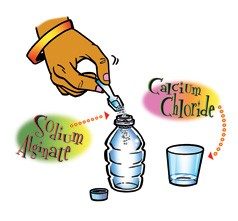
Teacher preparation for all groups
- Place ½ teaspoon calcium chloride in a cup. Add 25 mL of water and stir until the calcium chloride dissolves. Place about ½ teaspoon of calcium chloride solution into a small cup for each group.
- Place ¼ teaspoon sodium alginate powder in a plastic bottle. An empty disposable 8-oz plastic water bottle with a tight-fitting cap will work well.
- Carefully add 50 mL water to the bottle containing sodium alginate. Cap the bottle tightly and shake vigorously for about 30 seconds.
- Add another 50 mL of water to the bottle containing the sodium alginate solution. Optional: Add one drop of food coloring. Cap the bottle tightly and shake again.
- Pour one tablespoon (15 mL) of sodium alginate solution from the bottle into a portion cup or wide plastic cup for each group.
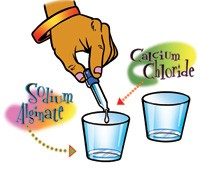
Procedure for students
Using a plastic dropper, add about 10 drops of calcium chloride solution to the center of the cup containing the sodium alginate solution.
Reach into the center of the solution (where you put the calcium chloride) and gently and slowly pull out the gel “worm.”
Place the “worm” on a paper towel.
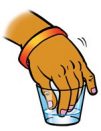
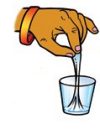
Expected Results
Students will be able to pull a long gelatinous string (worm) or blob from the cup.
Note: Remind students not to taste or eat the gel worm. Tell students that they have made a synthetic gel worm but that actual gel worms are manufactured using a different process and different ingredients.
Ask students
- What were the calcium chloride and sodium alginate solutions like when your teacher first gave them to you?
The calcium chloride solution was clear and colorless. It looked pretty much like water. The sodium alginate solution was also clear and colorless, but it seemed thicker. - After you added the calcium chloride solution to the sodium alginate solution and began pulling from the center, how did the solutions change?
Instead of flowing like a liquid, the chemical reaction made it come out of the cup like a gel. - Would you consider the gel worm to be a synthetic product? Why or why not?
The gel worm is a synthetic product because it was changed chemically and now has very different properties than the sodium alginate and calcium chloride solutions that were used to make it.
Clean-up
At the end of the lesson, have students pour their calcium chloride solutions down the drain with plenty of water or according to local regulations. Any extra sodium alginate solution and gel worms should be disposed of with the classroom trash. Have students wash their hands after cleaning up.
4 Explain
Step 6
Explain the chemical process of crosslinking which is used to make the synthetic gel worm.
Question 2 Continued: What chemical processes are used to make the synthetic product?
Tell students that in their research, they should look for the following clues about the chemical process(es) used to make their synthetic product:
- Can you identify one or more molecules involved in making the product?
- Do one or more chemical reactions take place?
- Are substances heated?
- Are substances put under pressure?
- Is special machinery used?
- Has the method changed over the years?
Explain that you will continue to use the gel worm as an example to guide the class about the kinds of information they should look for to answer the second question when researching their own synthetic product.
This explanation addresses the following:
- Can you identify one or more molecules involved in making the product?
- Do one or more chemical reactions take place?
Project the illustration Sodium alginate polymer.
Here are two models of a sodium alginate molecule. One is a ball-and-stick model showing all the atoms: 6 carbon atoms (black), 7 oxygen atoms (red), and 9 hydrogen atoms (white) and 1 positive sodium ion (purple). The other is a much simpler model using a hexagon shape for almost the whole molecule and a little circle for the positive sodium ion.
Notice that on both models the sodium ion has a positive charge and the place where it’s bonded to the molecule has a negative charge.
Many sodium alginate molecules are bonded together to make a long molecule called a polymer. Point out to students that each molecule is upside down compared to the one next to it.
Project the illustration Crosslinking sodium alginate.
To see what happens when calcium chloride is added, we need to use at least two sodium alginate polymer chains.
When the sodium alginate solution and the calcium chloride solution are mixed, the positive calcium ions replace the positive sodium ions. Since the calcium ions have two positive charges, the calcium ions bond with the negative area on two sodium alginate molecules and create a “crosslink” between the two chains. Many crosslinking chemical reactions cause the sodium alginate to thicken and become a gel.
Explain that since the final product is chemically different from the starting substances, a chemical synthesis occurred and the gel worm is a synthetic material.
Let students know that they may not be able to find this level of detail about the chemical process used to make their synthetic product. However, they should try to find something about the molecules or the characteristics of the materials before and after the process that synthesizes their product.
Step 7
Explain the impacts to society of making and using the synthetic product compared to making and using a more natural product with a similar function.
Question 3: What are some negative and positive impacts to society of making and using the synthetic product compared to making and using a more natural product with a similar function?
Have students imagine that the gel worms could be mass-produced with fruit flavoring, vitamins, and minerals to make a synthetic fruit snack. Explain that you will use the idea of a mass-produced gel worm as an example to guide the class about the kinds of information they should look for when researching the impacts of their synthetic product.
Tell students that in their research, they should look for the following kinds of environmental, social, and economic impacts that result from producing and using their synthetic product. They should also compare these impacts to the impacts of producing and using a less synthetic/more natural alternative with a similar function. Students should consider these questions:
- Are the natural resources used renewable or nonrenewable?
- What are the negative impacts of:
- Harvesting, mining, or collecting the natural resources
- Processing the natural resources before using them to make the final product?
- Producing the final product?
What are the positive impacts to society of using the final product?
Step 8
Consider the impacts of producing the synthetic gel worm snack compared to producing pieces of real fruit.
Renewable or Nonrenewable?
| Renewable and Nonrenewable Natural Resources Used to Make Each Snack | |||
Main | Natural resources used to make each | Renewable? | |
Gel worm | Sodium alginate | Brown Seaweed | Renewable, because seaweed reproduces within a few years. |
Calcium chloride | Limestone | Not renewable, because limestone is a rock that took millions of years to form. | |
Fresh fruit slices
| Fruit | Fruit tree, water, and soil nutrients | Renewable, because new trees can be planted, rain provides water, and good farming practices can replenish soil nutrients. |
Both sodium alginate and calcium chloride are natural resources. When considering our resources, it’s important to consider whether these are renewable or non-renewable.
If students are not familiar with these terms, introduce them now. Explain that renewable resources are replenished through natural processes in enough time to meet the need. For example, trees are renewable resources, but petroleum is not. Usually using renewable resources has less negative impact because the resource can be replenished.
Impacts from making synthetic gel worm snack
- Sodium alginate
Brown seaweed is harvested from the ocean in the wild. It is home and food for ocean creatures. Harvesting brown seaweed from the ocean could affect other organisms in the ecosystem. Processing seaweed into sodium alginate takes energy and produces waste which has to be controlled. - Calcium chloride
Have to mine limestone. This takes equipment which uses energy and pollutes. - Processing limestone to make calcium chloride produces waste which has to be controlled.
- Producing the gel worms
Mass-production of the gel worms in a factory takes equipment and uses energy. - Positive impacts
People (kids mostly) like eating them.
Impacts from making real fruit slices
- Grow and maintain the fruit trees
Prepare the land using large equipment. This uses energy and adds to pollution. Fertilize and water the trees. Some fertilizers can be pollutants if they get into lakes and rivers. In some areas, water may be less available than in others. Use of pesticides can be a possible pollutant. - Harvesting and slicing the fruit
Harvesting by hand is not polluting but harvesting by machine uses energy and adds to pollution. Cutting up the fruit into snack-size pieces would probably be done by machine which uses energy and adds to pollution. - Positive impacts
People like eating sliced fruit. Fresh fruit contains vitamins and nutrients essential for good health.
Conclusion
- Real fruit is probably healthier and might have fewer negative impacts. But if synthetic fruit snacks could be made with vitamins, other nutrients, and not too much sugar, they might be a possible alternative to real fruit slices.
5 Explore
Step 9
Have students investigate their synthetic product using internet and library resources.
Guiding Student Research
Discuss with students the importance of keeping track of the information they find, judging the reliability of the sources they use, and citing sources properly. You may already have resources for students on proper citation and on judging the reliability of sources.
- http://www.edutopia.org/blog/evaluating-quality-of-online-info-julie-coiro
- http://eduscapes.com/tap/topic32.htm
- http://www.scholastic.com/teachers/top-teaching/2010/11/reliable-sources-and-citations
- https://www.teachingchannel.org/videos/analyzing-websites-with-students
- https://www.cerias.purdue.edu/education/k-12/teaching_resources/lessons_pre-sentations/SITECREDIBILITY2.pdf
- http://www.readwritethink.org/classroom-resources/lesson-plans/ hoax-hoax-strategies-online-1135.html?tab=4
- http://www.easybib.com/reference/guide/mla/website
Note: Depending on the synthetic product students select, the information they find to answer the questions may vary in detail and completeness. Researching aspects of synthetic materials, natural resources, how products are made, and the impact of production on society can be challenging for students.
It can be difficult for students to find websites that are relevant, reliable, and understandable. Students may need substantial guidance to conduct research on the internet. We have provided some suggested websites as starting points for student research. Use your own expertise and that of the school library and media center to help students navigate to find useful material.
Main goals for student research
After students know the product they will research, remind them to look for the following information:
- What natural resources are used to make the synthetic product?
- What chemical processes are used to make the synthetic product?
- What are the negative and positive impacts to society of making and using the synthetic product, compared to making and using a more natural product with a similar function?
Encourage students to use the findings from their research to conclude whether the positives outweigh the negatives. If they would need more information to make that decision, ask students to identify what they would need to know.
Note: It may be challenging for students to find detailed and specific information on some aspects of the natural resources, production processes, and societal impacts for their synthetic materials and products. Encourage students to get as much information as they can to understand the basics of the resources that go into making the product, the general process for how it’s made, and the positive and negative impacts the production and use of the product have on society.
The following list is for students to compare the impact to society of their synthetic product to a more natural product with a similar function.
Products with similar functions (more synthetic/more natural)
- Plastic bag/ Paper bag
- Plastic container/ Glass container
- Disposable diaper/ Cloth diaper
- Synthetic fiber and cloth (polyester, nylon, or rayon) / Cotton, silk, or wool fiber and cloth
- Kevlar/ Steel
- Artificial sweetener/ Sugar
- Synthetic fuel (Synfuel)/ Petroleum
- Synthetic rubber/ Natural rubber
- Chloroquine (Malaria drug)/ Cinchona tree bark
- Taxol(Cancer drug)/ Yew tree bark
- Physostigmine(Glaucoma drug)/ Calabar beans
- Aspirin/ Willow tree bark
The following websites can help students begin their research on their synthetic product.
Plastic Bags
- Stopwaste.org, From Oil to Plastic
- The Atlantic, What is Crude Oil, Exactly?
- How Stuff Works, Plastics
- How Stuff Works, Which is more environmentally friendly: paper or plastic?
- Canadian Plastics Industry Association, All About Bags, Paper vs. Plastic Bags
- Ecomyths Busted, Myth: Paper Bags Are Greener Than Plastic
Plastic Bottles
- American Chemistry Council, The Basics: Polymer Definition and Properties
- Thomasnet.com, Plastic Bottle Manufacturing
- Explain That Stuff!, Glass
- Environmental Impact, Environmental Impact of Glass Production
- The Vermont Juice Co., Glass vs. Plastic
- Washington Post, Why glass jars aren’t necessarily better for the environment than plastic jars
Disposable Diapers
- Stanford Alumni, Don’t Pooh- Pooh My Diaper Choice
- National Geographic, How Disposable Diapers are Made
- Appropedia, Cloth vs. Disposable Diapers
- Healthline, The Diaper Wars: Cloth vs. Disposable
Synthetic Fiber and Cloth (Polyester, Nylon, Rayon)
- ChemMatters, Nylon (PDF)
- Explain That Stuff, Nylon
- Smithsonian, How 75 Years Ago, Nylon Stockings Changed the World
- How Products are Made, Rayon
- Chemistry Explained, Fibers
- How Stuff Works, Why is Cotton More Absorbent than Nylon?
- Sewing Parts Online, Cotton vs. Polyester
Kevlar
Artificial Sweetener
- ChemMatters, The Skinny on Sweeteners: How Do They Work? (PDF)
- ChemMatters, Artificial Sweeteners (PDF)
- Scientific American, Sugar vs. Artificial Sweeteners
- CNN, Real or Fake Sugar: Does it Matter?
- American Chemical Society, Environmental Science and Technology, Artificial Sweetener Persists in the Environment (PDF)
- World Wildlife Fund, Sustainable Agriculture – Sugarcane
Synthetic Rubber
- American Chemical Society, National Historic Chemical Landmarks, U.S. Synthetic Rubber Program
- Explain that Stuff, Rubber
- Akron Global Polymer Academy, A Brief History of Rubber
- Discovery Communications, How It’s Made - Synthetic Rubber
Synthetic Fuel
- ChemMatters, Do You Want Biodiesel with That? (PDF)
- ChemMatters, Green Gasoline: Fuel from Plants (PDF)
- How Stuff Works, What is a Synfuel?
- How Stuff Works, Top 8 Synthetic Fuels
- Princeton University, Synthetic Fuels Could Eliminate U.S. Need for Crude Oil
Taxol (Cancer drug)
- National Cancer Institute, Natural Compound Helps treat Breast and Ovarian Cancer
- National Cancer Institute, Success Story – Taxol
- American Chemical Society, National Historic Chemical Landmark – Discovery of Camptothecin and Taxol (PDF)
- American Chemical Society, Chemical and Engineering News - Taxol
Physostigmine (Glaucoma drug)
- ChemMatters, Percy Julian: Rising above Racism
- Chemical Heritage Foundation, Science Alive, Physostigmine and Glaucoma
- American Chemical Society, National Historic Chemical Landmark, Percy L. Julian and the Synthesis of Physostigmine
Chloroquine (Malaria drug)
Cortisone (Arthritis drug)
- Encyclopedia.com, Percy Lavon Julian
- PBS, NOVA, Percy Julian : Forgotten Genius – Making Cortisone from Plants
Aspirin
6 Extend
Step 10
Have students make an advertisement, poster, short video, article, or other output about their synthetic product.
Student projects should address the following questions:
- What natural resources are used to make the synthetic product?
- What chemical processes are used to make the synthetic product?
- What are the negative and positive impacts to society of making and using the synthetic product, compared to making and using a more natural product with a similar function?
Encourage students to use the results of their research to conclude which product would be the best choice for society.
What is the 5-E format?
The 5-E instructional model is an approach to teaching and learning that focuses on active engagement, inquiry-based learning, and collaboration.
Downloads
For Students
- Lesson 6.12 Student Activity Sheet PDF | DOCX | Google Doc
For Teachers
- Lesson 6.12 Lesson Plan PDF | DOCX | Google Doc
- Lesson 6.12 Activity Sheet Answers PDF | DOCX | Google Doc
Resources for the entire Chapter 6
- Chapter 6 Student Reading PDF | DOCX | Google Doc
- Chapter 6 Test Bank PDF | DOCX | Google Doc
Have Questions? Visit Help Center
